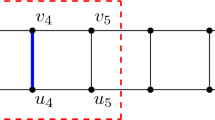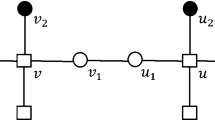Abstract
We investigate a competitive version of the coloring number of a graph G = (V, E). For a fixed linear ordering L of V let s (L) be one more than the maximum outdegree of G when G is oriented so that x ← y if x < L y. The coloring number of G is the minimum of s (L) over all such orderings. The (a, b)-marking game is played on a graph G = (V, E) as follows. At the start all vertices are unmarked. The players, Alice and Bob, take turns playing. A play consists of Alice marking a unmarked vertices or Bob marking b unmarked vertices. The game ends when there are no remaining unmarked vertices. Together the players create a linear ordering L of V defined by x < y if x is marked before y. The score of the game is s (L). The (a, b)-game coloring number of G is the minimum score that Alice can obtain regardless of Bob’s strategy. The usual (1, 1)-marking game is well studied and there are many interesting results. Our main result is that if G has an orientation with maximum outdegree k then the (k, 1)-game coloring number of G is at most 2k + 2. This extends a fundamental result on the (1, 1)-game coloring number of trees. We also construct examples to show that this bound is tight for many classes of graphs. Finally we prove bounds on the (a, 1)-game coloring number when a < k.
Similar content being viewed by others
References
Faigle U., Kern U., Kierstead H. A. and Trotter W. T.: On the game chromatic number of some classes of graphs, Ars Combinatorica 35 (1993), 143–150.
Guan D. and Zhu X.: Game chromatic number of outerplanar graphs. J. Graph Theory 30 (1999), 67–70.
Kierstead H. A.: A simple competitive graph coloring algorithm. J. Comb. Theory (B) 78 (2000), 57–68.
Kierstead H. A.: Asymmetric graph coloring games, (2002) manuscript.
Kierstead H. A.: Weak acyclic coloring and asymmetric graph coloring games, (2002) manuscript.
Wu J. and Zhu X.: Lower bounds for the game colouring number of partial k-trees and planar graphs, (2003), manuscript.
Zhu X.: Game coloring number of pseudo partial k-trees. Discrete Math. 215 (2000), 245–262.
Zhu X.: Refined activation strategy for the marking game, (2003), manuscript.
Author information
Authors and Affiliations
Corresponding author
Rights and permissions
About this article
Cite this article
Kierstead, H.A., Yang, D. Very Asymmetric Marking Games. Order 22, 93–107 (2005). https://doi.org/10.1007/s11083-005-9012-y
Received:
Accepted:
Published:
Issue Date:
DOI: https://doi.org/10.1007/s11083-005-9012-y




